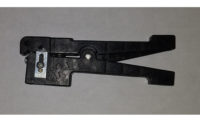SFP Connectivity for Existing Fiber Optic Links

Our industry needs to focus on providing usable high technology products and services for our end users. Pulling new cables when there are existing functional unused fiber optic links and Category cables is not only a waste of time and money, but such installations are more costly to the end user. The cost of cabling will be directly reflected in the quality and (possibly) quantity of state-of-the-art electronic devices that a customer ends up with in their system.
With the dramatic developments in IP networking and PoE device powering, new avenues of connectivity are being introduced by vendors, providing multiple options for those installation companies who know how to exploit existing cabling. The key to using existing cable is performing simple tests on the target cables to ensure their quality, and planning to replace any existing connectors, be they copper or fiber, since in most cases cabling connectivity problems can be traced to the connector ends. Testers for copper and fiber are now reasonably priced, especially when you consider that if a pair of unused fiber links are tested “OK” IP signals can be shot across the building, around the campus or up to ten kilometers away.
One of my favorite manufacturers in our industry is Altronix. It is consistently innovating its products to provide flexibility for installation companies when connecting and powering IP/PoE devices. Plus, specific Altronix products are “hardened” with wide temperature operating ranges, and can be purchased in Nema 4/4X weatherproof enclosures for outside installation.
The enhanced “Netway Spectrum” product line demonstrates how the usage of high-power PoE along with Small Form Factor Pluggable (SFP) fiber optic link modules provides tremendous flexibility for installation companies when connecting to existing network infrastructure such as switches and fiber links. The basic concept is to help installation companies overcome UTP cabling distance limitations while providing long-distance network connectivity via SFP modules with fiber optic links.
The hardened NetwaySP3B can be network connected using a single inexpensive SFP module. To connect to the next switch the Netway SP1A media converter uses a UTP jumper and the appropriate SFP module to provide the connectivity needed.
Selecting the correct Altronix devices for your applications is very simple and straightforward. First, count the number of “local” IP devices that will be connected to a particular Netway switch, and calculate the aggregate PoE power needed. The Netway switches can be obtained with 3, 4 or 8 UTP Ethernet ports onboard. Then, consider the SFP requirements; if a Netway switch is to be installed mid-span, the switches can be purchased with dual SFP sockets; if the switch is the “last in line,” single SFP socket switches can be used. Select the appropriate power supply to provide sufficient wattage for the switch’s operation and its PoE outputs; pick an enclosure that will work with the environment (indoor or outdoor); order the switch/power supplies with the necessary SFP modules (singlemode or multimode); and you are set to go.
Altronix has an extensive network of field representatives whose job is to assist you in planning and implementing their equipment in a correct and cost-efficient way.
Keep in mind that to use existing fibers and cables they should be tested for functionality before the installation commences, and end users should be informed in writing that if your system plan includes using existing cables, they must meet minimum industry standards for performance, or they may have to be re-connected or possibly replaced.
Looking for a reprint of this article?
From high-res PDFs to custom plaques, order your copy today!






